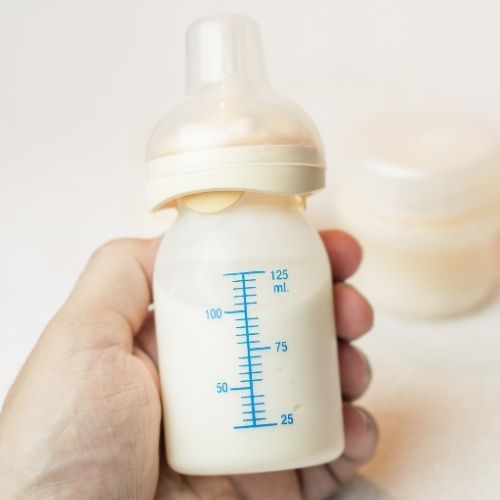These milk boosters will help increase your breast milk supply fast! You can increase your milk supply when pumping and breastfeeding with these great tips.
Breastfeeding isn’t always as easy as it seems. New moms are often nervous they are not making enough milk for their baby and are desperate to find ways to boost supply fast!
It’s important to note that you won’t make much milk in the first few days. You can follow this guide for getting your milk to come in faster.
To make more milk, you need to tell your body what to do! You can do this by consuming galactagogues (foods that improve lactation), by feeding or pumping more, or by changing some of your personal habits. This list will guide you through each of these.
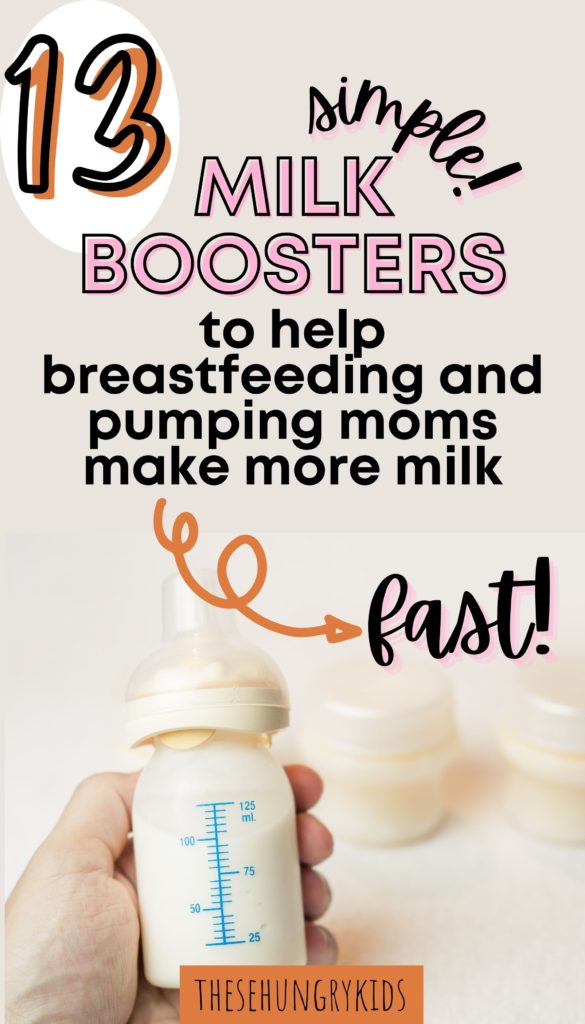
This post contains affiliate links, to products I love, and for your convenience. This means if a purchase is made using a link on this post, I may earn a small commission at no additional cost to you. This helps keep this site up and running, and I thank you for supporting my small business!
Breastfeeding tips for producing more milk
1. Drink lactation Tea
The research is really vague on whether Mother’s Milk tea actually works for boosting milk supply. The promise it will improve milk supply is anecdotal, but many moms swear that it helped increase their breast milk supply!
What we do know is that Mother’s Milk tea is safe for mom and baby, and it is unlikely to hurt your supply. This is why it is my first breastfeeding tip for producing more milk.
When I notice a dip in my supply, I drink a 1-2 cups of Earth Mama Organic’s Milkmaid tea. It tastes great, and I do notice an increase in the amount of milk I make afterwards.
Drinking lactation tea is such a simple thing to add to your daily routine that doesn’t add calories or affect postpartum weight loss. Plus, since hydration is so important when it comes to breastfeeding, it’s never a bad idea to add a cup of tea to your day.

2. Try lactation supplements
Similar to lactation or galactagogue tea, it’s not clear whether breastfeeding supplements in pill form really work. In fact, some moms notice a drop in supply after taking some supplements (particularly in those containing fenugreek.)
Herbal supplements may be worth a try, however. Especially if you are desperate to increase your milk supply fast! This one in particular has great reviews.
Most breastfeeding supplements contain ingredients like fenugreek, fennel, thistle and anise. Fenugreek seems to be one of those ingredients that moms either respond positively or negatively to. You can also try this highly rated fenugreek-free supplement if you are concerned about the potential drop in supply with the addition of fennugreek.

If you are struggling with clogged milk ducts, adding a sunflower lecithin supplement will help prevent clogs. While clogged milk ducts are generally harmless, they can contribute to painful breastfeeding, infection, and can reduce milk supply over time.
Related: 7 Ways To Help Your Milk Come In Faster After Birth
3. Improve your hydration (water, coconut water, sports drinks, Body Armor)
It’s no secret that hydration is important when breastfeeding. You probably notice that you are thirstier than usual when breastfeeding.
Drinking extra fluids may help increase your supply. This is especially important if you have recently started a postpartum workout routine, or if you are noticing a dip in your supply after returning to work and aren’t able to drink as much. Plus, the overall exhaustion and demands of motherhood might mean you’re not drinking enough water.
Adding in an electrolyte-packed beverage may be a good idea, especially if you are having a hard time drinking enough water. Drinks like coconut water and sports drinks (think Gatorade, Powerade or Body Armor) may help your body use the water you’re drinking more effectively.
This is one of the most simple breastfeeding tips for producing more milk.
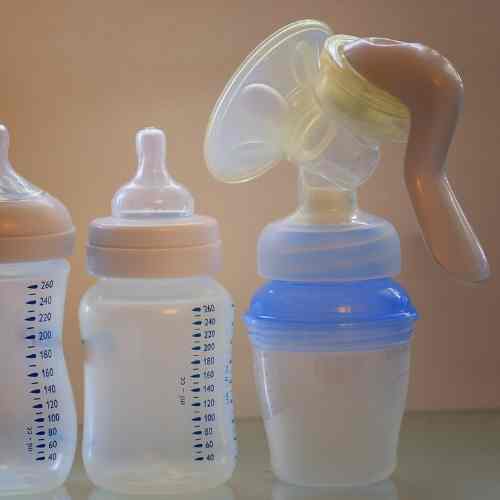
4. Power pumping to improve milk supply
Do you remember how the first few days after your baby was born when they wanted to eat constantly? That’s called cluster feeding, and the goal is to signal your body to make more milk. Basically, power pumping is a method of pumping that is meant to mimic cluster feeding.
With power pumping, you will pump for a period of time, and then stop for a short amount of time before pumping again. It’s a very effective way to increase breast milk production.
The easiest way to power pump is by using your electric pump. It can be done with a manual breast pump as well, but it will take a bit more effort. Don’t worry if you don’t see a ton of milk flow after the first or second round – you are sending signals to your body that more milk is needed!
A sample power pumping schedule may look like:
- 20 minutes of pumping
- 20 minutes of rest
- 15 minutes of pumping
- 15 minutes of rest
- 10 minutes of pumping
Breastfeeding is supply and demand, so pumping this way signals your body to boost the milk supply!
You should try power pumping after your baby nurses, or when you know your child will not need to eat for a while. That way you can be sure there is enough milk for their next feeding.

Related: How Long Does Reheated Breast Milk Last? A Guide For Milk Storage
5. Eat foods that increase lactation
There are some foods that are believed to increase milk supply. As mentioned above, these milk boosters are called galactagogues.
The most well known galactagogues are oatmeal, brewer’s yeast, tea, flax seeds, fennel and fenugreek.
To boost milk supply, try starting your day with a hearty oatmeal! Top it with some flax and chia seeds and mix in a little brewer’s yeast. I love this banana chocolate chip oatmeal as a convenient everyday breakfast.
Lactation cookies are not only a great treat, but they may also increase milk supply! You can try a homemade recipe, a store bought mix, or stick with a store bought cookie for convenience. They often include ingredients like oatmeal, yeast, and flax seeds.
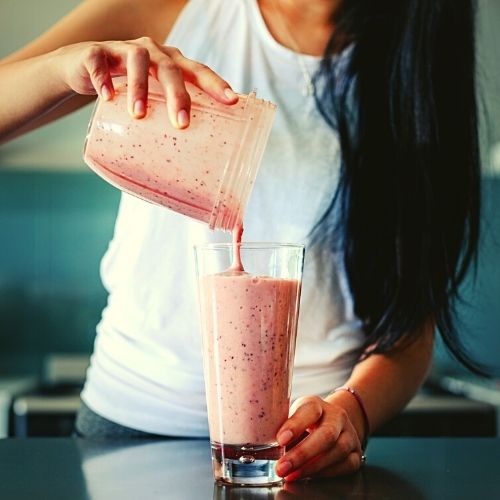
For a healthy snack or meal replacement, you can also try lactation smoothies. You can make any shake a lactation shake with a few simple ingredients.
6. Avoid foods that may hurt your milk supply
Things like peppermint, alcohol, sage and oregano may hurt your supply. You don’t have to avoid them completely, but it may be helpful to limit them.
Related: How To Prevent Blowout Diapers – Simple Tips To Save Your Sanity
7. Pump after nursing
This goes back to the supply and demand aspect of breastfeeding. If you want to increase your supply, you have to have increased demand. If you pump immediately after breastfeeding, you will trick your body into thinking the baby needs more milk.

Don’t expect a lot of milk from these pumping sessions – the goal is to send the message that more milk is needed. Whatever milk you get is a bonus! You can start building your freezer stash easily with that milk.
Adding an extra pumping session will increase the amount of milk your body produces. You may not make much breast milk at first, but after a few days you will likely get several ounces of milk.
8. Check your nutrition
Are you eating and drinking enough? Are the foods you are eating high in healthy fats, vitamins and minerals?
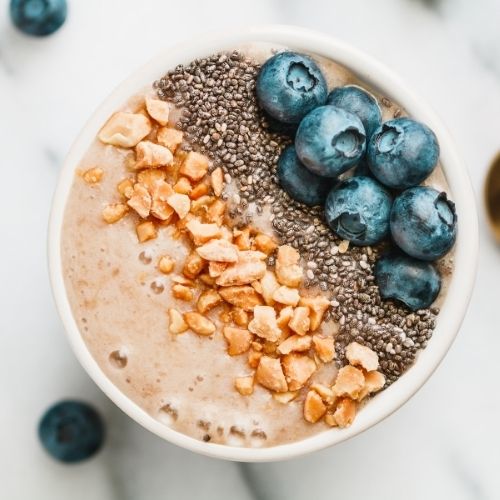
Many moms try to shed the extra baby weight by slashing calories, but that may hurt your milk supply. Instead, try to focus on high quality foods and exercise.
Breastfeeding moms need between 450-500 extra healthy calories every day to maintain breast milk supply. You can get those extra calories in a hearty breastfeeding-safe protein shake (I love my Boobie Body mix!), or with an extra snack during your nursing sesh.
9. Relax (stress might be killing your supply!)
According to this article from UT Southwestern Medical Center, the rising cortisol and other hormones associated with stress can kill your milk supply!
Having a baby is extremely stressful. Your sleep schedule has been thrown off, you have a needy little person, and breastfeeding can be very difficult and time consuming in the early days! Stressing out is easy in those early days.

And, not to mention that babies feed off of your energy! Your stress and anxiety can make for a fussy baby. You can read some of my favorite techniques for calming a fussy baby here.
Relaxing is my personal favorite of the breastfeeding tips for producing more milk. Try relaxing and viewing breastfeeding as a time to wind down and snuggle your baby.
Also, take time to practice self care and relax. Doing relaxation exercises like yoga or meditation may help you feel calmer. And don’t be afraid to ask for help when you need it!
10. Feed baby from the breast as much as possible
While it’s OK to pump and give your baby a bottle every once in a while, feeding your baby from the breast may help boost milk supply.

There’s a few reasons for this, with the biggest one being the nipple stimulation that comes with breastfeeding. This triggers hormone release that can cause an increase in breast milk supply.
Doing skin-to-skin contact while nursing can help you establish a healthy milk supply from the early weeks. Feed on baby’s demand and soak up the extra snuggles. Follow baby’s cues for when to start nursing. When the baby is alert, calm, and turning their head, it’s a good time to start a nursing session.
11. Use warm compresses
Number 11 on the list of breastfeeding tips for producing more milk is to use warm compresses either during feeds or before feeding your baby.
Warm, moist heat can sometimes stimulate breastmilk production. When showering, position yourself so the warm water hits your chest. Some parents notice a significant increase to their milk supply after a warm bath or shower!
When nursing your baby, place a warm compress over the breast. This may temporarily increase blood flow to the breast tissue and help your baby get enough breast milk during their feeding.
12. Try massaging
Gently massaging your breast before or during a feeding can help with increasing milk supply. Especially in the early days, hand expression of milk before a feeding can help make it easier for baby to latch and draw milk.
Breast massage is a bit different than the relaxing spa massage you may be used to. Start toward the top of the breast and gently massage toward the nipple. For best results, pair with a warm compress. This method may help you get a little bit of extra milk.
13. Visit a lactation consultant

There’s a possibility that the baby’s latch isn’t correct and that can cause a low milk supply. Also, you could be using your breast pump incorrectly, which can hurt your supply too.
Lactation consultants can assess your breastfeeding and pumping from a big picture standpoint. They may be able to offer advice to improve your milk supply by changing your breastfeeding position, helping your baby’s latch, or by ensuring you are using the pump properly. For example, if you are using the wrong size pump flanges or aren’t comfortable with all of the pump parts, you may not be pumping most effectively.
A lactation specialist can assess all of the common reasons moms aren’t making enough milk. Check to see if there is an international board certified lactation consultant (IBCLC) in your area. Many insurance companies will cover the visit.
PRO TIP! You can try a virtual lactation consultant appointment with Lactation Mamas if leaving the house feels too stressful or risky. They also offer breastfeeding courses that can help you navigate your breastfeeding journey with ease.
How to know if your baby is getting enough milk
The best way to know if a baby is getting enough milk is to watch your baby’s cues. A baby that is relaxed with open fists and is sleepy after a feeding is likely getting enough milk.
Your baby’s pediatrician will also monitor your baby’s health. They will make note of any weight gain or weight loss compared to their birth weight, ask about their dirty diapers, and will take note of baby’s behavior before or after a feed.

A nursing baby that is grunting and fussy after eating is not getting enough milk. In the early days, babies should be relaxed and sleepy after a feed. If a baby is fussy or screaming, they may still be hungry.
If you’ve tried any of these milk boosters, have they worked for you? These are my tips to improve lactation and your milk supply and what has worked for me, so I am hopeful they work for you, too!


